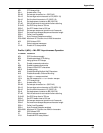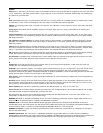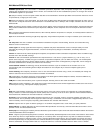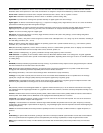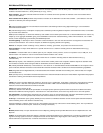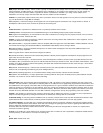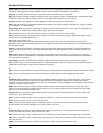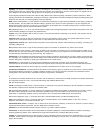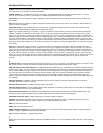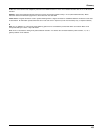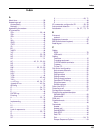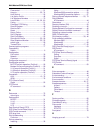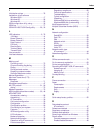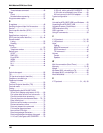
102
MultiModemISDN User Guide
terminal—The screen and keyboard device used in a mainframe environment for interactive data entry. Terminals have no
box
, which is
to say they have no file storage or processing capabilities.
terminal adapter (TA)—An ISDN DTE device for connecting a non-ISDN terminal device to the ISDN network. Similar to a protocol
converter or an interface converter, a TA connects a non-ISDN device between the R and S interfaces.
tone dialing—One of two methods of dialing a telephone, usually associated with Touch-Tone® (push button) phones. Compare with
pulse dialing
.
TSR (terminate and stay resident)—A software program that remains active and in memory after its user interface is closed. Similar to a
daemon in UNIX environments.
twisted pair wiring—A type of cabling with one or more pairs of insulated wires wrapped around each other. An inexpensive wiring
method used for LAN and telephone applications, also called UTP wiring.
Type A: The upstream (USB Type A) connector. A Type A Connector is for those devices on which the external cable is permanently
attached. Connectors for USB come in two designs: the 'A' and 'B' types. Upstream connections (computer, hub input, etc.) are made
using the 'A' type connector, downstream connections (peripherals, hub outputs) are made using the 'B' type connector. The USB spec
defines two types of connectors to protect the bus from illegal topologies (e.g., connecting one downstream port back to another, etc.) and
to prevent end-user confusion. This allows end users to easily attach the correct connectors to peripherals and ports. Type A Plug and
receptacle are to be used for those devices on which the external cable is permanently attached to devices such as Keyboard, mouse and
hubs. Series B Plug and receptacle are to be used for those devices that require an external detachable cable such as printers, scanners
and modems.
Type B: The uplink (USB Type B) connector. A Type B Connector is for detachable external cables. Allows for double ended cable
assemblies. Connectors for USB come in two designs: the 'A' and 'B' types. Upstream connections (computer, hub input, etc.) are made
using the 'A' type connector, downstream connections (peripherals, hub outputs) are made using the 'B' type connector. The USB spec
defines two types of connectors to protect the bus from illegal topologies (e.g., connecting one downstream port back to another, etc.) and
to prevent end-user confusion. This allows end users to easily attach the correct connectors to peripherals and ports. Type A Plug and
receptacle are to be used for those devices on which the external cable is permanently attached to devices such as Keyboard, mouse and
hubs. Series B Plug and receptacle are used for devices that require an external detachable cable such as printers, scanners and
modems.
U
U reference point—A twisted-pair subscriber loop that connects the LT to the NT1. Normally a 2-wire BRI or PRI line is used, but a 4-wire
BRI can also be used. In the US, the U Reference Point marks the separation point between CPE and the network.
UHCI (Universal Host Controller Interface): The USB Universal Host Controller Interface. All transfers on the USB are initiated by the host
system’s host controller. The host controller is responsible for controlling traffic on the USB and can be appropriately programmed to transfer
data to and from USB devices. This is typically a PCI device that can be programmed to run a given schedule of transfers on the USB and
bus master the results into memory for processing by the host software. There are currently two standards for host controllers: OpenHCI
(OHCI or Open Host Controller Interface) and UHCI (Universal Host Controller Interface). Both these standards define register level
interfaces of the host controller to PCI bus. Bandwidth allocation over the USB is software managed and is done by the programming of the
host controller.
Universal Serial Bus: A collection of Universal Serial Bus devices and the software and hardware that allow them to connect the
capabilities provided by functions to the host.
Universal Serial Bus Device: Includes hubs and functions. See device.
Universal Serial Bus Driver: The host resident software entity responsible for providing common services to clients that are manipulating
one or more functions on one or more Host Controllers.
Universal Serial Bus Interface: The hardware interface between the Universal Serial Bus cable and a Universal Serial Bus device. This
includes the protocol engine required for all Universal Serial Bus devices to be able to receive and send packets.
Unshielded Twisted Pair (UTP): Telephone-type wiring. Tansmission media for 10Base-T.
Upstream: The direction of data flow towards the host. An upstream port is the port on a device electrically closest to the host that
generates upstream data traffic from the hub. Upstream ports receive downstream data traffic.
USB: See Universal Serial Bus.
USBD: See Universal Serial Bus Driver.
USB Performance categories: Low Speed (Interactive Devices at 10-100 Kb/s); Medium Speed (Phone, Audio, Compressed Video at
500Kb/s - 10Mbp/s); High Speed (Video, Disk at 25-500 Mb/s)
UTP (unshielded twisted pair) —Telephone-type wiring.
V
V.110—One of the terminal rate adaptation protocols for the ISDN B-channel. V.110 is more hardware-intensive than the V.120 B-channel
standard.



